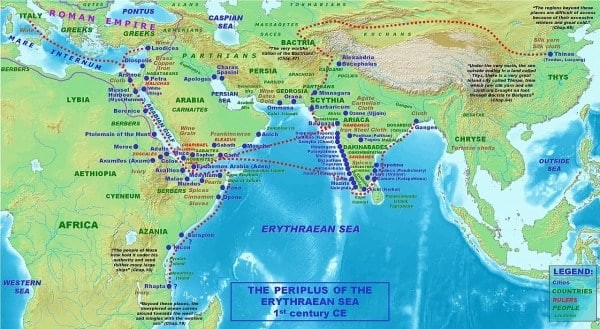Description

Disclaimer: Copyright infringement not intended.
Context
- The India-Middle East-Europe Economic Corridor, announced at the G20 Summit, hearkens back to an ancient trade route linking the subcontinent and the Roman Empire.
Details
Rediscovering the Ancient Red Sea Trade Route
- Throughout the ages, historians have acknowledged the existence of trade between Rome and India in antiquity.
- Sir Mortimer Wheeler's excavations during the 1930s and 40s at Arikamedu near modern-day Pondicherry confirmed Indo-Roman trade during the 1st century CE.
- Yet, an oversight prevailed, as Indian merchants and ship owners were not fully credited for their pivotal role in this exchange.
The Vast Scale of the Trade
- Unveiling the magnitude of this trade route was a recent revelation.
- Current estimates suggest that custom taxes from Red Sea trade with India, Persia, and Ethiopia contributed up to one-third of the Roman exchequer's income.
- This astounding revelation stems from the Muziris Papyrus, a document authored by an Alexandria-based Egypto-Roman financier.
- The document pertains to goods acquired from an Indian merchant based in distant Muziris on the Kerala coast.

Economic Impact on the Roman Empire
- The Muziris Papyrus discloses an import tax exceeding two million sesterces on cargo valued at almost nine million sesterces.
- By the 1st century CE, Indian imports into Egypt may have exceeded a billion sesterces annually, contributing substantially to the Roman Empire's finances.
- These revenues eclipsed those of entire subjugated nations and were indispensable for maintaining the expansive Roman Empire.
Trade Commodities on the Red Sea Route
- Luxuries from India, such as malabathrum (reminiscent of cinnamon), ivory, pearls, gemstones, and especially pepper, were highly sought after across the Roman Empire.
- Notably, Indian pepper became a staple, featuring in about 80% of the recipes within the Roman cookbook of Apicius.
Trade from Rome to India
- Conversely, trade in the opposite direction saw the export of gold to India, creating a trade imbalance. Records also hint at Indians developing a taste for Roman wine.
Organization and Duration of the Trade
- Contracts between Kerala merchants and Alexandria shippers indicated a well-structured trade network.
- Goods were transported in containers, mirroring modern cargo vessels.
- Indian mariners adeptly harnessed monsoon winds, allowing for a six to eight-week journey from India to Egypt.
Indian Involvement in the Trade
- Indians and Indian dynasties exhibited keen interest in seafaring.
- Notably, Indian sailors prominently featured in the trade, leaving their mark in locations such as the Hoq caves on the Socotra island.
Red Sea Trade vs. Silk Road
- Contrary to contemporary perceptions, the Red Sea trade route during the Roman era eclipsed the Silk Road in historical importance.
- The concept of the Silk Road, as we understand it today, was absent in ancient times. Sino-European interactions were limited, making the focus on the Silk Road anachronistic.
Recent Rediscovery and Future Inquiries
- Emerging evidence continues to illuminate the Red Sea trade route's significance.
- Questions regarding India's impact during this period, its role in global trade, and its influence on ideas persist.
- While Indian scholars have made substantial contributions to this field, broader efforts are needed to disseminate these findings widely.

Conclusion
The ancient Red Sea trade route stands as a remarkable testament to the tapestry of global commerce. It underscores India's pivotal role in bridging East and West and offers valuable insights into the intricate web of ancient trade networks. As new evidence unfolds, we gain a deeper understanding of historical interactions that have shaped our world.
|
PRACTICE QUESTION
Q. Discuss the significance and historical implications of the ancient Red Sea trade route between India and the Roman Empire. Analyze the economic, cultural, and maritime aspects of this trade route, and compare its importance with the Silk Road during the Roman period. (250 Words)
|
https://indianexpress.com/article/explained/explained-history/william-dalrymple-maritime-trade-route-india-europe-silk-road-8935580/







